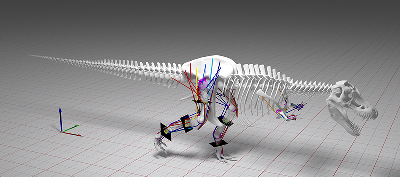Dr Sellers’ discovery suggests that the size and sheer mass of the T. rex would render it physically impossible to move at any speed higher than 7.7mph, which is slower than the average man’s running speed, which is around 8.4mph. Any speed higher than that would cause the T. rex’s legs to simply break during chase due to its immense weight.
His research team took advantage of Manchester’s free access to the Tier 2 HPC facility N8 HPC to generate intense and detailed simulations. Dr Sellers’ team combined two popular bio mechanical techniques – multi-body dynamic analysis (MBDA) and skeletal stress analysis (SSA) to create a more refined model which he and his team used to prove their theory. This isn’t the first time MBDA and SSA have been used to measure the walking and running ability of dinosaurs. However, it is the first time they have been used together to literally create a more accurate picture.
Dr Sellers explains: ‘Our previous simulations of theropod bipedal running did not directly consider the skeletal loading but these new simulations do calculate all the forces in the limb bones and these can be used directly to estimate the bone loading on impact.’
Dr Sellers’ results disrupt the idea that the T. rex was primarily a high-speed pursuit predator – a topic which has been an intensely debated subject matter amongst the palaeontology community for decades. The research suggests a less athletic lifestyle for the T. rex and even throws into question their hunting methods. Furthermore, their results bring into question the maximum running speeds of other large two-legged dinosaurs such as: Giganotosaurus, Mapusaurus, and Acrocanthosaurus.
Dr Sellers has stated that the ‘Tyrannosaurus rex is one of the largest bipedal animals to have ever evolved and walked the earth. So it represents a useful model for understanding the biomechanics of other similar animals.’
Dr William Seller’s research can be found in PeerJ. If you are interested in accessing the computational power of N8 HPC, contact us for further details or see our website.

